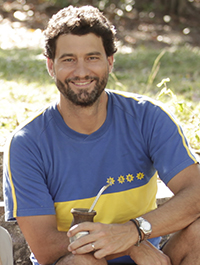Cannes artists: the rise and rise of fake award entries.
July 8, 2025

By Gonzalo López Martí – Creative Director
What is false and what is real in 2025?
Would you break up with your significant other because they have fake breasts, fake nose, fake hair, fake teeth, a fake waistline, Turkish hair plugs or a Brazilian butt lift?
Welcome to the French Riviera.
A sunny place for shady people*.
Another Cannes festival, another déjà vu.
Counterfeit campaigns galore.
So far this year, 12 awards were rendered null & void for cheating: 1 Grand Prix, 3 Golds, 4 Silvers and 4 Bronzes.
Back in the pre-social media era, it was harder to spot the so-called “truchos”**.
Times have changed but it all remains the same.
It has never been easier to create a faux campaign (thank you, artificial intelligence).
It has never been easier to call it out (thank you, social media).
Latin American agencies, particularly them Brazilians, are NOTORIOUS for submitting dubious work to awards shows.
This year’s Cannes edition was no exception.
Africa Creative DDB, based in São Paulo, of all places, won three gold lions with campaigns that, allegedly, did not really see the light of day in the form they were submitted.
DM9 (another Brazilian agency part to the DDB network) had to pull three submissions.
To the extent that DM9’s Co-President and CCO, Icaro Doria, was forced to resign in shame.
In a different category, Gut, a creative boutique founded by a Brazilian and an Argentine, and currently owned by Argentine consultant firm Globant, faced a public imbroglio too over a lion it won with a campaign for a Dutch beer in which, purportedly, the agency had little to no involvement***.
They stole someone else’s work and entered it as their own, pretty much.
Allegedly.
Lo & behold: Gut’s global CEO, Andrea Díquez, was the president of the jury who awarded her own agency the prize***.
You can’t make this shit up.
LOL
Ok, enough schadenfreude.
No one will ever put this on a press release or admit it on the record, but award shows have always been an opaque affair ensnared in hypocrisy.
Juries negotiating in sordid smoke-filled rooms to bring trophies to their shops has been commonplace since forever.
To be sure, the crooked horse-trading dynamic was not created by Latin Americans.
It was already there when we joined the party.
Ask a Latin American ad executive about the whole charade, and they will tell you that they didn’t write the rules, they just play by them.
It is a flimsy moral justification, but a justification nonetheless.
If you like sausages, laws and advertising awards, don’t ask how they make’em.
The problem is not “a few bad apples”.
POSIWID: “the Purpose Of a System Is What It Does”. ****
Should we just bask in the cynicism and wallow in the bullshit?
Is there a light at the end of the sham tunnel?
Let’s see the glass ½ full.
To be somewhat fair, most of the entries in hot water are not entirely spurious.
Usually, they are an embellishment of a real rollout.
It just so happens that the current way we submit campaigns to award shows -the proverbial “case study”- provides ample room for augmentation, fabrication, and hallucination.
Still, these “case studies” usually contain a kernel of truth.
To his credit, Nizan Guanaes, legendary Brazilian copywriter, founder of Africa Creative DDB, partial owner of DM9, and one of the most adept and prolific manufacturers of bogus submissions in the history of our racket, used to be candid enough to admit it.
His point -I’ll paraphrase- was something along these lines: the clothes you see at a Paris fashion show -let alone the body types- aren’t real and nobody seems to object.
You will never see an actual Formula One or Nascar car on the street.
Fair enough.
An award show is exactly that: a show.
A sandbox for research and development.
A circle jerk to let the creative juices flow, to vent steam, to cheer up demoralized brittle hipsters who survive on a steady diet of rejection for breakfast, lunch and dinner.
I tend to agree.
Ghost ads are the good ol’ “idea in search of a client”
If we truly are in the business of creativity, we need to let our imagination fly.
It’s what we do for a living, it’s in our DNA: we put lipstick on pigs.
At times, this might detach us from reality.
It is true, however, that it’d be healthier for agencies seeking visibility and reputation through concocted ads to openly acknowledge the fiction.
I would be the first to raise hell if an entry of mine, a real campaign approved by a real client, got second place to a phony figment of some weaselly creative director’s imagination.
Then again, would you reject a romantic date with someone who had some work done?
What would you do, say, if your daughter got pummeled at a tennis tournament by a trans player who was born male?
*The line is not mine. It is attributed to British writer W. Somerset Maugham (1864-1965). The phrase is usually applied to Miami and LA too.
** Spanish slang for fake ads (not to be confused with fake news)
*** The award in question is a Gold Lion in Creative Effectiveness. The brand in question is Hertog Jan, part of the global Anheuser-Busch InBev portfolio of beer labels: https://adage.com/events-awards/cannes-lions/aa-hertog-jan-gut-controversy/?utm_id=gfta-ur-250630&share-code=35IRA2SHKFHZFMZMWKK7SAG5UA&user_id=user-id&customer_secondary_source=aac_articleGifting
**** Line is not mine either. It was coined by Brit management consultant Stafford Beer.




























